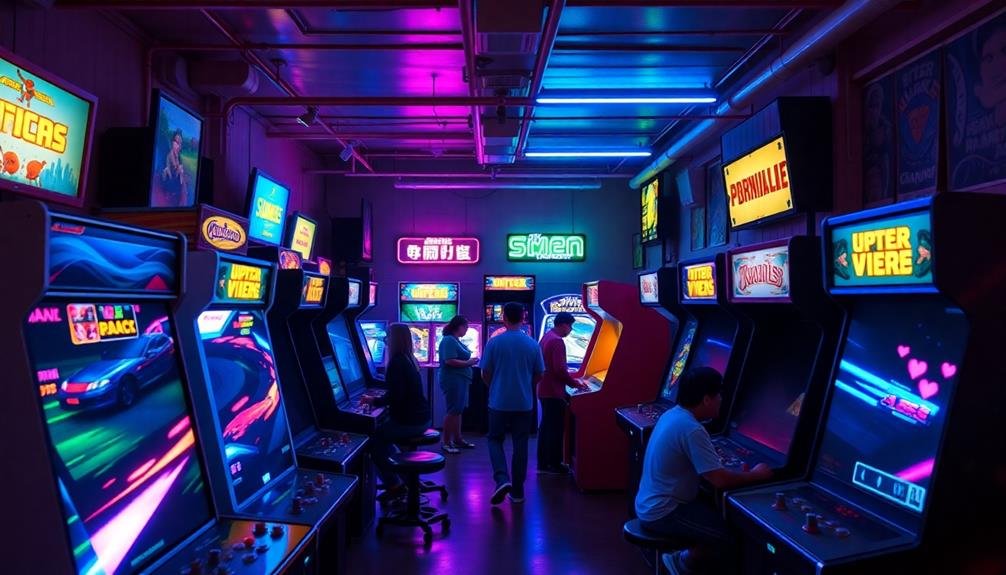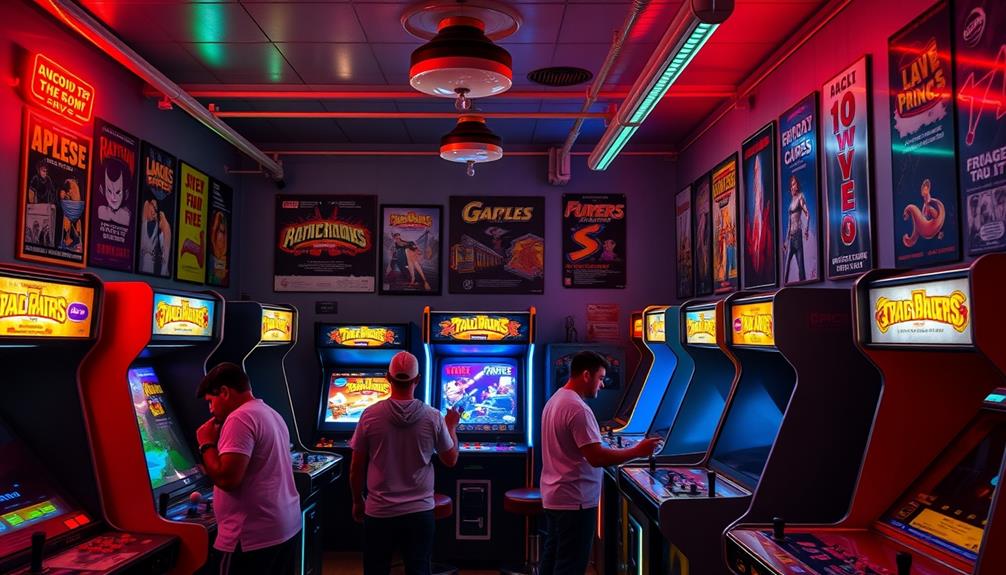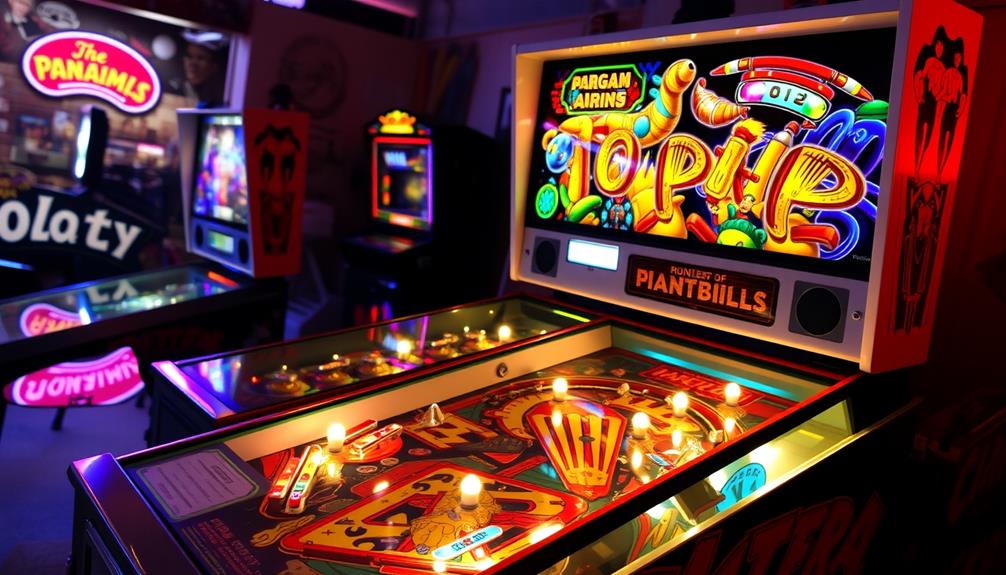Arcade games tend to be expensive due to high production costs and the necessity of specialized components. They are constructed with sturdy materials to endure heavy usage, leading to an increase in prices. Licensing fees for popular franchises also play a significant role in driving up costs, as manufacturers must pay royalties that can escalate the total price by thousands. Additionally, the niche market contributes to the maintenance of high prices, as there is demand from collectors and enthusiasts. Moreover, ongoing maintenance costs can further inflate the overall ownership costs. If you are interested in learning more about the various factors that influence these prices, there is a wealth of information to explore regarding this compelling topic.
Key Takeaways
- High production costs arise from durable materials, sophisticated hardware, and intricate designs required for arcade machines.
- Licensing fees for popular franchises significantly increase retail prices, adding thousands to production expenses.
- Limited market competition allows manufacturers to maintain elevated pricing strategies for profitability.
- Specialized components and ongoing maintenance requirements contribute to overall ownership costs.
- Nostalgia and collector demand for rare titles drive prices up, reflecting perceived value in the gaming culture.
Factors Influencing Arcade Game Pricing
When considering arcade game pricing, several key factors come into play. First, you should know that arcade machines typically cost vendors between $2,500 and $7,000. This range reflects the high production costs linked to durable materials and specialized components designed for public use.
Additionally, modern arcade machines often incorporate space-saving options to meet the needs of smaller game rooms, which can also impact pricing. Licensing fees also greatly inflate retail prices. Manufacturers often pay substantial amounts to original creators for rights to popular franchises, which can drive up costs.
Another vital factor is the limited market for arcade games. With fewer potential buyers compared to mainstream entertainment, vendors must adopt higher pricing strategies to guarantee profitability.
Additionally, ongoing maintenance and support are essential for keeping arcade machines operational. These costs are factored into the initial pricing models, further elevating the price point.
Lastly, the production of arcade machines is often pricier than that of home consoles. Lower production volumes, advanced technology, and labor-intensive manufacturing processes all contribute to the higher costs.
Understanding these factors will give you insight into why arcade games are priced the way they are, making it clear that quality and durability play important roles in the overall pricing strategy.
Quality and Advanced Features
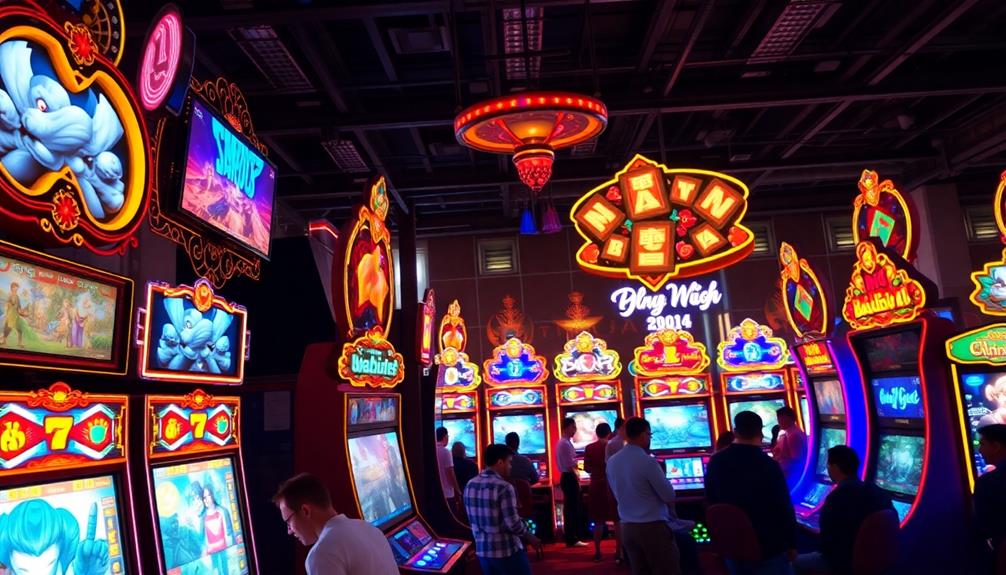
Arcade games stand out in the entertainment landscape due to their quality and advanced features, which greatly enhance the gaming experience. These games utilize cutting-edge technology that elevates gameplay, including innovations seen in best-rated pinball machines that showcase intricate designs and advanced mechanics, but this innovation comes at a cost.
Intricate design and engineering are necessary to create the immersive environments you enjoy, leading to higher production expenses. The high-quality graphics in arcade games are another factor driving up costs. To deliver stunning visuals, manufacturers need sophisticated hardware, which can be pricey.
Furthermore, the interactive features that make arcade games exciting require durable and specialized components, often more expensive than standard consumer electronics. Additionally, the development and manufacturing processes for arcade machines are labor-intensive. Skilled workers invest time and expertise into crafting these machines, further increasing the overall cost.
Ultimately, the combination of these advanced features and the unforgettable experiences provided by arcade games justifies their elevated pricing in the market. When you play, you're not just enjoying a game—you're experiencing a meticulously crafted piece of entertainment technology that reflects the investment made to bring it to life.
Specialized Components and Materials
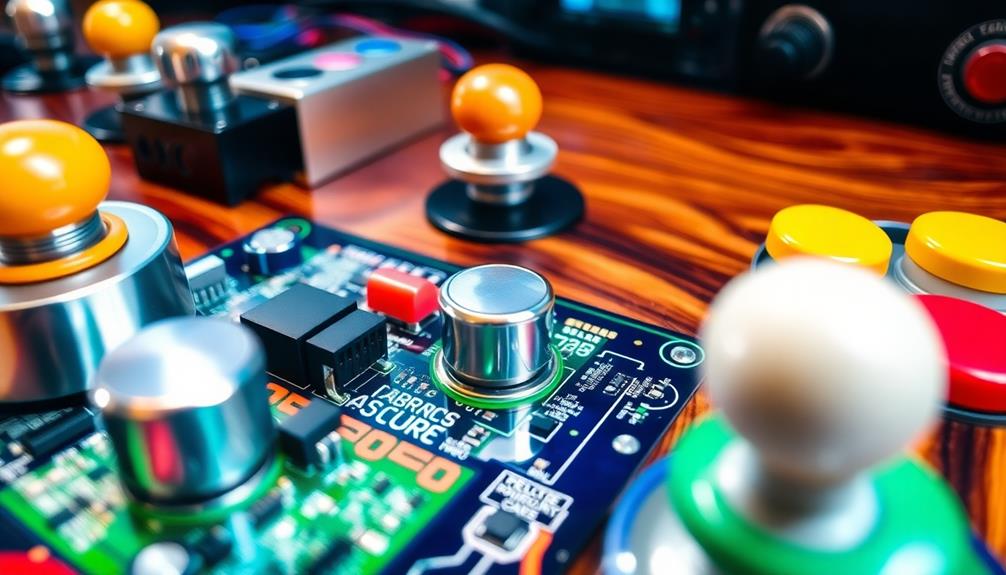
When you think about arcade games, consider how the choice of durable materials plays an essential role in their longevity.
The use of specialized components can be likened to the benefits of airless paint sprayers in guaranteeing a smooth and consistent application, which is vital for high-quality finishes.
Customization options can greatly drive up costs, as they require specialized components designed for high-traffic environments.
Reliability is key, and the right materials guarantee these machines can withstand heavy use without sacrificing performance.
Durable Material Selection
Choosing the right materials for arcade cabinets is vital to guarantee they stand up to the demands of heavy public use. The use of durable materials, like plywood and heavy-duty plastics, guarantees longevity but also contributes to higher production costs. Specialized hardware components designed for arcade machines provide reliability in high-traffic environments, yet these custom parts are pricier than standard consumer electronics.
Here's a quick overview of the materials used in arcade cabinets:
| Material Type | Purpose |
|---|---|
| Plywood | Structural integrity |
| Heavy-duty plastics | Durability against wear |
| Specialized hardware | Enhanced performance |
| High-quality graphics | Visual appeal |
| Advanced technology | Reliable gaming experience |
The emphasis on durability means that arcade cabinets often require labor-intensive development and manufacturing processes. This attention to detail boosts the overall cost of the materials used. Additionally, if you opt for customization, such as unique artwork or specialized controls, expect even higher prices due to increased labor and material costs. In the end, selecting durable materials is vital for guaranteeing arcade cabinets can endure the rigors of public use.
Customization and Costs
Customization options can greatly impact the overall cost of arcade cabinets. When you choose unique artwork or personalized controls, you're not just adding flair; you're also increasing production costs. These elements often require specialized hardware components that are more expensive than standard electronics, as they need to withstand the demands of high-traffic environments.
Additionally, the increasing popularity of arcade games, akin to the resurgence of pinball machines, has led to a greater demand for unique and custom designs.
Moreover, the labor-intensive design and production processes involved in creating customized features can drive prices even higher. Customization isn't just about aesthetics; it also involves sophisticated engineering and interactive features that contribute to the overall costs.
Additionally, the reliance on specialized parts, which aren't mass-produced, makes it harder to keep prices low. Each customization you select can lead to a ripple effect on the final pricing. You might find that a simple change in design can elevate the costs considerably due to the need for durable materials and high-quality components that can endure constant use.
Ultimately, while customization adds a personal touch to arcade cabinets, it also plays an essential role in driving up costs. So, when you consider customizing your arcade game, be prepared for the financial implications that come along with it.
Reliability for High Traffic
How can arcade cabinets withstand the relentless wear and tear of high-traffic environments? The secret lies in their construction. Built from durable materials, these cabinets are designed to endure heavy use, ensuring both longevity and reliability.
Unlike typical consumer electronics, the hardware components in arcade machines are engineered specifically for public use, leading to higher manufacturing costs. This is akin to how top-rated heat pumps are designed for peak performance in demanding conditions.
Specialized parts, like joysticks and buttons, are more expensive due to their required durability and responsiveness in busy settings. When you're in an arcade, you want the experience to be seamless, and that means investing in high-quality components.
Customization options also play a role in driving up component prices, as businesses often seek unique features to attract players while maintaining reliability.
With arcade games, the need for dependable operation in high-traffic locations necessitates a significant investment in quality materials. This is why you'll find that arcade games come with a higher price tag—they're not just games; they're robust machines designed to withstand the test of time and heavy usage.
In the end, that investment translates to a better experience for everyone involved.
Licensing Fees and Royalties

When you consider arcade games, licensing fees can really affect what you pay.
These fees are often tied to the popularity of the game's characters and franchises, which can greatly inflate costs. If a game features a popular franchise, those intellectual property costs can skyrocket, driving up retail prices.
This demand for beloved characters not only boosts prices but also complicates profitability for manufacturers, making it essential to understand the impact of common financial terms on overall costs.
Franchise Popularity Impact
The impact of franchise popularity on arcade game pricing is significant, largely due to the licensing fees and royalties involved. When you consider classic games tied to popular franchises, you'll see that manufacturers often face hefty licensing agreements. These agreements can inflate production costs substantially, adding thousands to the overall price of arcade machines featuring licensed content.
In a similar manner to how IRA rollovers can influence investment strategies, the financial dynamics of arcade games are shaped by the high costs associated with franchise popularity.
As demand for these popular franchise games rises, manufacturers need to recoup those licensing fees and maximize profitability. This demand influences the entire supply chain, driving up the prices of arcade games. Because of this, you might notice that the production runs for licensed arcade games can be limited, making them more sought after. Consequently, the resale prices for these machines often skyrocket, reflecting their high demand.
Ultimately, the franchise popularity impact on pricing isn't just about the upfront costs; it affects the perceived value and availability of arcade games in the market.
Intellectual Property Costs
Steering through the world of arcade games often leads you to uncover the hefty intellectual property costs tied to licensing fees and royalties. When it comes to old games, these costs can greatly inflate production expenses.
Licensing agreements for popular franchises frequently require substantial fees that manufacturers must navigate. Additionally, similar to how a Gold IRA can provide diversification, arcade manufacturers must consider how their choice of licensed properties can affect their overall investment strategy.
Consider these factors impacting the costs:
- Franchise Popularity: Well-known characters or brands command higher licensing fees.
- Rights Holder Payments: Fees to original creators can be substantial, affecting pricing.
- Market Competition: Manufacturers often pass on licensing costs to consumers.
- Collector Demand: Enthusiasts are willing to pay a premium for beloved titles.
As you explore the arcade scene, you'll notice that these intellectual property costs squeeze the profitability of manufacturers. They must balance hefty licensing fees against potential revenue, making it challenging to keep prices competitive.
Consequently, the arcade games you cherish—especially those that feature iconic characters—are often accompanied by higher price tags. Understanding these costs can help you appreciate why certain old games are priced the way they are, as the love for nostalgic titles comes at a premium.
Profitability and Demand
Maneuvering the arcade game market reveals a direct link between profitability and the demand for licensed titles. When you consider the rising popularity of certain franchises, it becomes clear that manufacturers are willing to pay hefty licensing fees to secure the rights to use these intellectual properties. This upfront cost considerably impacts production expenses, but it's a gamble that often pays off.
The ongoing trend of trending topics in gaming culture further fuels this demand, encouraging manufacturers to invest in recognizable titles. As you explore the market, you'll notice that arcade games featuring well-known titles typically command higher prices. Vendors and manufacturers are keen to capitalize on this popularity, which allows them to implement elevated pricing strategies.
Furthermore, each licensed game incurs ongoing royalty payments, further contributing to the final retail price. The profitability of manufacturers hinges on this high demand. Games tied to popular culture don't just sell well; they also maintain higher resale values, reinforcing the justification for those initial costs.
Ultimately, the interplay between licensing fees and consumer interest creates a landscape where profitability can thrive, despite the apparent high price tags attached to these beloved arcade machines.
Market Demand and Niche Audience
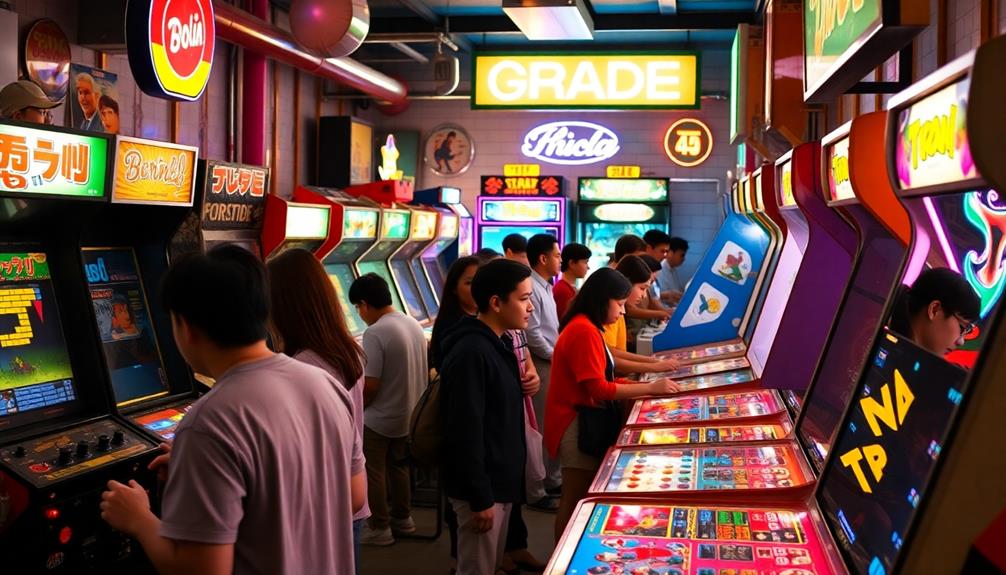
While many gaming markets cater to a broad audience, arcade games thrive within a niche community of dedicated enthusiasts and businesses. This specialized market drives demand, often resulting in higher prices for various games. Limited potential buyers mean vendors must guarantee profitability, which reinforces elevated pricing structures.
Additionally, the allure of unique themes and decor in arcade games can parallel the charm found in Paula Deen's Wedding Highlights, further appealing to collectors and enthusiasts alike.
Here are some key factors influencing market demand:
- Popularity of Titles: Some games can generate over 50 times their purchase price in operational revenue, justifying higher costs.
- Limited Competition: Vendors face little competition, allowing them to maintain higher pricing strategies without worrying about inventory turnover.
- Collectible Appeal: Unique offerings, like pinball machines, can appreciate in value, attracting collectors and increasing market demand.
- Nostalgia Factor: The collective nostalgia for classic arcade games fuels interest among collectors, leading to soaring prices for rare and vintage titles.
Ultimately, the interplay of these factors guarantees that arcade games remain a cherished yet costly investment for those in the niche community.
As demand continues to exceed supply, you'll see prices reflect that scarcity and the unique value of these games.
Maintenance and Repair Considerations

Owning arcade games comes with its own set of maintenance and repair challenges that can greatly impact your investment. Repair costs for machines, especially pinball units, can be substantial due to their intricate electronic components.
You'll often find that the complexity of these systems requires specialized expertise, further driving up expenses. Additionally, the demand for replacement parts contributes to overall maintenance costs, making it essential for you to budget accordingly.
If you buy used arcade machines, be wary of undisclosed issues that could lead to unexpected repair costs. New or refurbished units often come with fewer surprises, which can save you money in the long run.
Regular maintenance, such as software updates and physical repairs, is important to keep your games running smoothly. This ongoing upkeep adds to the overall cost of ownership.
Furthermore, the need for expert repairs can make maintaining older machines more expensive than investing in newer models. As a result, these maintenance and repair considerations can considerably influence the pricing dynamics of arcade games, making it critical for you to carefully evaluate your options before making a purchase.
Collector Trends and Nostalgia
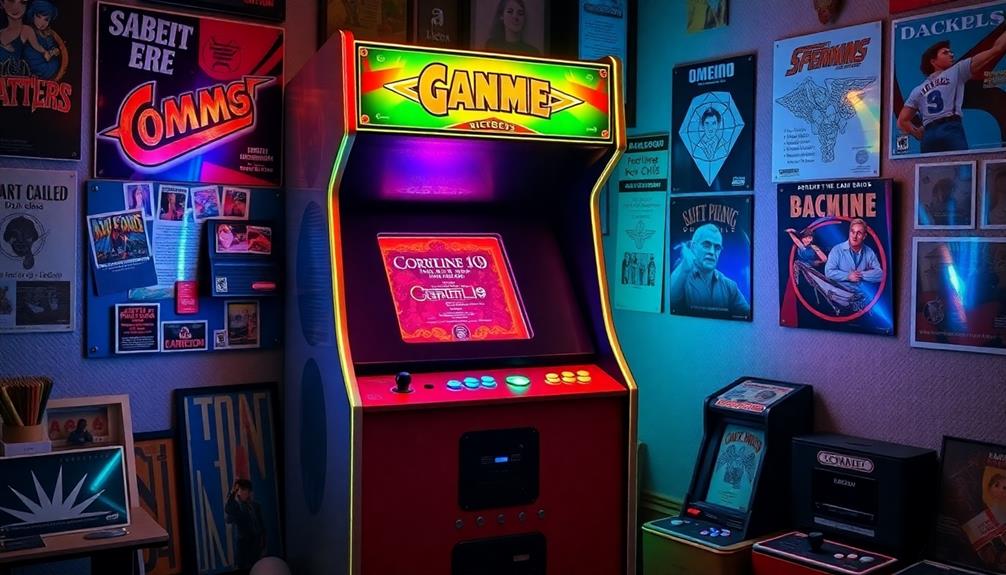
As you navigate the world of arcade games, understanding the growing trends among collectors can greatly impact your purchasing decisions. Nostalgia plays a significant role in this market, particularly for games that are now 30-40 years old. The demand for classic titles like Atari's Tempest and Midway's Mortal Kombat has skyrocketed, leading to inflated prices.
Key factors influencing collector trends include:
- Nostalgia: Many collectors seek to recapture their childhood experiences with games from the late 1970s to mid-1990s.
- Rare Collectibles: The sale of items like a sealed Super Mario Bros. for $2 million highlights the financial potential of nostalgic games.
- Media Influence: Films and books about arcade culture have elevated interest, driving prices higher.
- Economic Factors: Increased disposable income among Generation X and Y encourages spending on childhood favorites.
With collectors holding onto high-demand titles longer, market availability decreases, further inflating prices.
Understanding these trends can help you make informed choices as you plunge into the exciting world of arcade game collecting.
Alternatives to Traditional Arcade Games
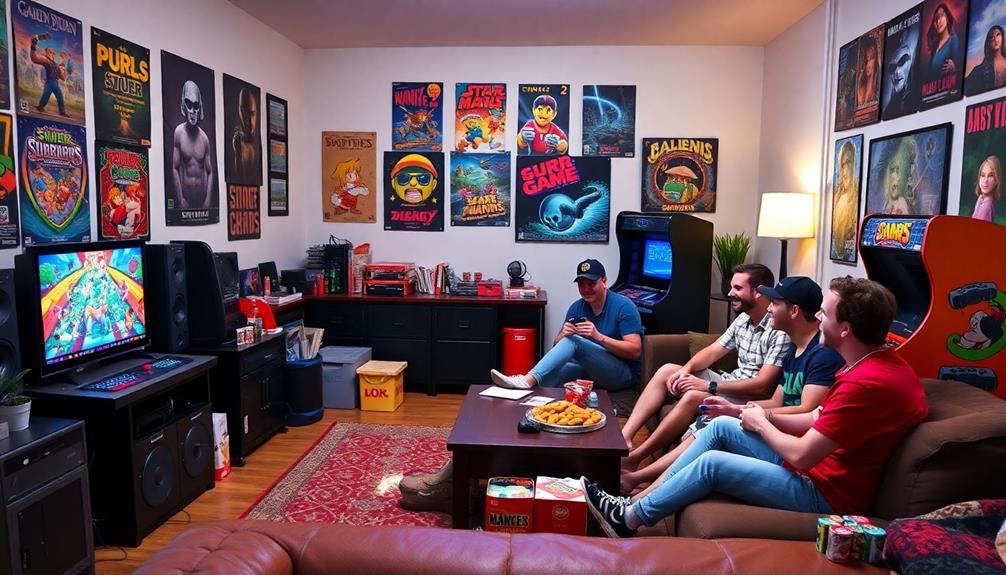
If you're looking for ways to enjoy classic arcade games without breaking the bank, there are plenty of exciting alternatives available. Years ago, arcade machines were the only way to experience your favorite games, but now, emulators and PC versions let you relive those nostalgic moments at a fraction of the cost. That’s not to say that arcade machines don’t have their charm, but for those looking to save some money, emulators and PC versions are a great option. The accessibility and affordability of these alternatives have made it easier for people to understand why arcade games were popular in the first place – the fast-paced gameplay, competitive spirit, and the thrill of trying to beat high scores all contribute to the timeless appeal of classic arcade games.
Retro gaming consoles, like the NES Classic or Sega Genesis Mini, come pre-loaded with multiple classic titles, making them a budget-friendly option.
You might also consider DIY arcade kits, which allow you to build your own machine, giving you both customization options and lower upfront costs compared to buying an assembled unit. If you're not keen on building, replica arcade cabinets can provide the aesthetic appeal of traditional machines without the steep prices of originals.
Don't underestimate online forums and communities dedicated to game emulation. These platforms offer valuable resources and support, helping you recreate the arcade experience at home.
With these alternatives, you can enjoy the thrill of arcade gaming without the hefty price tag typically associated with traditional arcade cabinets.
Frequently Asked Questions
How Much Does the Average Arcade Game Cost?
The average arcade game costs between $2,500 and $7,000. More specialized machines can reach over $20,000, while vintage games often retain high resale values, reflecting their ongoing demand and collector's interest.
Why Are Games so Expensive Nowadays?
Games are becoming pricier due to skyrocketing development costs, lengthy production times, and rising consumer expectations. You're paying for high-quality graphics, immersive experiences, and extensive marketing—factors that all contribute to the increased prices you see.
Why Did Arcade Games Lose Popularity?
Arcade games lost popularity as home consoles and mobile gaming became more accessible. You now prefer gaming anywhere, anytime, and the decline of dedicated arcades means fewer opportunities for you to enjoy those nostalgic experiences. The rise of home consoles and mobile gaming offered convenience and a wider variety of games, making it easier for gamers to access their favorite titles without having to leave their homes. However, the decline of dedicated arcades also means missing out on the social aspect of playing games with friends and strangers in a public space. This communal experience is part of why arcade games were popular in the first place, creating a sense of camaraderie and competition among players.
Are Arcade Games Still Profitable?
Yes, arcade games can still be profitable, especially in high-traffic areas. If you choose popular titles, you'll attract players and generate consistent revenue, effectively recouping your investment and maintaining a steady income over time.
Conclusion
So, while arcade games might seem pricey, remember that their value often reflects quality, nostalgia, and the unique experience they offer. You might think you can find cheaper alternatives, but nothing quite matches the thrill of playing on a classic cabinet. Investing in an arcade game not only brings joy but also a slice of gaming history into your home. Embrace the experience; it's worth every penny for those unforgettable moments of fun!

